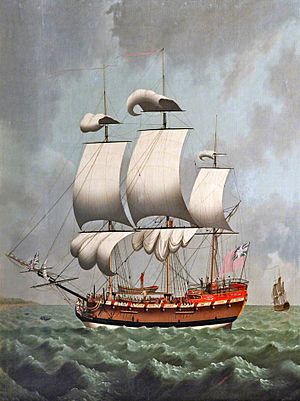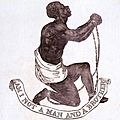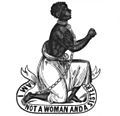Atlantic slave trade facts for kids

The Atlantic slave trade was a sad period in history when millions of African people were taken from their homes and sold as slaves. This happened mainly across the Atlantic Ocean, from the 15th century (the 1400s) to the 19th century (the 1800s). Most of these enslaved people were forced onto ships in West Africa and brought to the New World (the Americas). This journey was often called the Middle Passage.
Many enslaved people were captured during battles or through violent raids and kidnapping. Some were sold into slavery as a punishment for crimes or to pay off a debt, often by other Africans. They were then chained together and forced to march for weeks or months to the coast. Once there, they were held in forts until Europeans bought them. Historians believe that between 12 million and 13 million Africans were brought to the Americas as slaves.
The Dahomey army, for example, was involved in this trade. They exchanged enslaved people for weapons to protect their kingdom. King Gezo of Dahomey said in the 1840s:
The slave trade is the ruling principle of my people. It is the source and the glory of their wealth...the mother lulls the child to sleep with notes of triumph over an enemy reduced to slavery...
Contents
What Was the Atlantic Slave Trade?
The Atlantic slave trade is sometimes called the Maafa by African and African-American scholars. This word means catastrophe in Kiswahili, an African language. Some slave ships followed a three-part trading route known as the triangular trade. This route connected the economies of different regions and continents. The main countries involved in this triangular trade were England, The Netherlands, France, Spain, and Portugal. Other ships focused only on transporting enslaved people.
Christopher Columbus arrived in the Americas in 1492. This discovery created a big economic reason for the transatlantic slave trade. Enslaved people were first brought in large numbers to work in mining. Later, they were forced to grow sugarcane on huge farms called plantations. Slavery itself is much older than the transatlantic trade. People were enslaved in many ancient societies around the world.
How the Trade Began to End
In the 18th century (the 1700s), people in Britain, America, and parts of Europe started to speak out against the slave trade. In Britain and America, groups like the Religious Society of Friends (Quakers) and other religious leaders, such as William Wilberforce, led the fight. However, landowners in the Americas who relied on enslaved labor strongly opposed these efforts. After 1772, any enslaved person who reached the British Isles became free.
Denmark was the first country to ban the slave trade in 1792, with the ban taking effect in 1803. Britain followed by banning the slave trade in 1807. They put in place strict fines for any slave found on a British ship under the Slave Trade Act. The Royal Navy then worked to stop other nations from continuing the trade. On February 22, 1807, William Wilberforce's hard work paid off. The British House of Commons voted overwhelmingly to abolish the Atlantic slave trade. However, enslaved people continued to be sent to the Spanish colonies of Puerto Rico and Cuba until much later in the 19th century.
Related pages
Images for kids
-
Reproduction of a handbill advertising a slave auction in Charleston, South Carolina, in 1769.
-
Portrait of Ayuba Suleiman Diallo (Job ben Solomon), painted by William Hoare in the 18th century
-
Wedgwood anti-slavery medallion, produced in 1787 by Josiah Wedgwood
-
Charles II of Spain. On November 7, 1693, Charles issued a Royal Decree, providing sanctuary in Spanish Florida for fugitive slaves from the British colony of South Carolina.
-
Cowrie shells were used as money in the slave trade
-
West Indian Creole woman, with her black servant, circa 1780
-
William Wilberforce (1759–1833), politician and philanthropist who was a leader of the movement to abolish the slave trade.
See also
 In Spanish: Comercio atlántico de esclavos para niños
In Spanish: Comercio atlántico de esclavos para niños























